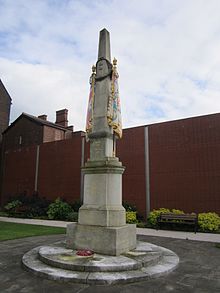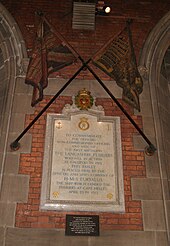Lancashire Fusiliers War Memorial
| Lancashire Fusiliers War Memorial | |
|---|---|
| England | |
 | |
| For men of the Lancashire Fusiliers killed in the First World War | |
| Unveiled | 25 April 1922 |
| Location | 53°35′32″N 2°17′55″W / 53.59226°N 2.29872°W Gallipoli Gardens, Bury, Greater Manchester, England |
| Designed by | Sir Edwin Lutyens |
Listed Building – Grade II* | |
| Official name | War Memorial to the Lancashire Fusiliers, Gallipoli Gardens |
| Designated | 2 September 1992 |
| Reference no. | 1250814 |
The Lancashire Fusiliers War Memorial is a
The memorial was unveiled by Lieutenant General Sir Henry de Beauvoir De Lisle on 25 April 1922, using the novel method of pressing an electric button. The remaining funds were spent on drums and bugles for the regiment and donated to the Lancashire Fusiliers' compassionate fund. After the Lancashire Fusiliers were amalgamated into the Royal Regiment of Fusiliers in 1968, the memorial was adopted by the new regiment and rededicated to all fusiliers killed in action. It originally sat outside the Lancashire Fusiliers' headquarters in Wellington Barracks but was relocated when the barracks closed in the 1970s. It was moved again in 2009, this time to sit in a public park renamed Gallipoli Gardens, outside the Fusilier Museum, which moved at the same time. The memorial was designated a grade II listed building in 1992. It was upgraded to grade II* in 2015 (on the centenary of the Cape Helles landing), along with two other memorials related to the Gallipoli Campaign; later that year it was recognised as part of a national collection of Lutyens' war memorials.
Background
In the aftermath of the
Lutyens' father was Captain Charles Henry Augustus Lutyens (1829–1915), formerly an officer in the Lancashire Fusiliers. Captain Lutyens, himself the son of an army officer, spent most of his military career in Canada; he served during the time of the

The Lancashire Fusiliers (previously the 20th Regiment of Foot) was swollen by thousands of volunteers during the First World War, predominantly recruited from the towns to the north and west of
Commissioning

By the end of the war, 13,642 Lancashire Fusiliers had been killed, including 600 at Cape Helles alone. The regiment earned 18 Victoria Crosses (including the "six before breakfast"), more than any other infantry regiment. The loss of so many men, and the losses at Gallipoli in particular, deeply affected the local community in Lancashire and especially Bury, where the regiment was headquartered. A ceremony to commemorate the Cape Helles landing has taken place every year since 1916 in the parish church, which contains a memorial to the Lancashire Fusiliers' efforts at Cape Helles, placed by the crew of HMS Euryalus (which carried the bulk of the 1st battalion to Gallipoli).[1][11][12][13]
In light of the regiment's heavy losses, there was a strong feeling that their war efforts should be commemorated. This led Colonel George Wike to convene a meeting in
Design

The memorial was built by John Tinline of Bury, a local stonemason. It consists of a single tall, tapering obelisk in Portland stone (similar to the pair on Lutyens' Northampton War Memorial) standing on a square base with a cornice where the two parts meet. Below the base is a carved frieze which sits on a pedestal of two rectangular blocks. The whole structure rests on a rectangular plinth and at the very bottom are two shallow circular steps. On the front and rear of the obelisk are carvings of the Lancashire Fusiliers' cap badge and the inscription "XX" (referring to the 20th Regiment of Foot, from which the Lancashire Fusiliers evolved) in gilded lettering, surrounded by a carved laurel wreath. On the front, below the wreath, the regiment's motto, OMNIA AUDAX ("daring in all things", awarded for the fusiliers' service in the Second Boer War), is inscribed. To either side are carved, painted flags: the King's Colour to the north (left when the memorial is viewed from the front) and the colour of 1st Battalion, the Lancashire Fusiliers to the south (right). The obelisk itself is 4 metres (13 ft) tall and the whole memorial is 6.9 metres (23 ft) tall.[1][16][17][18][19]
The remaining inscriptions are all to the lower part of the structure. The dates of the First World War are carved just below the obelisk, and the dedication TO THE LANCASHIRE FUSILIERS THEIR DEEDS AND SACRIFICES FOR KING AND COUNTRY on the upper part of the pedestal. Below those, on the lower part of the pedestal and on the plinth, are later inscriptions: the dates of the Second World War and the further dedication AND ALL FUSILIERS WHO DIED IN SUBSEQUENT CAMPAIGNS (the latter added after the Lancashire Fusiliers' amalgamation in the 1960s).[1] The architectural historian Nikolaus Pevsner opined that the memorial is one of the few beautiful public artefacts in an otherwise "drab" group of towns,[2][17][20] and "more moving in its modesty" compared to some of Lutyens' grander designs for municipal war memorials.[21]
History
The memorial was unveiled by Lieutenant General

When the Lancashire Fusiliers were amalgamated with other fusilier regiments into the Royal Regiment of Fusiliers in 1968, the new regiment adopted the memorial and rededicated it to commemorate all fusiliers killed in the line of duty. It stood in its original location outside the regimental headquarters at Wellington Barracks for over 40 years, but the barracks closed with the amalgamation and were mostly demolished in the 1970s. As a result, the memorial was moved to the side of Bolton Road, outside the front gate of the former barracks. In 2009, Sparrow Park was redeveloped as Gallipoli Gardens and the Fusilier Museum moved there from the former regimental headquarters. The war memorial was dismantled and repaired before being re-installed next to the museum. Lutyens' grandson, Lord Ridley, unveiled the memorial in its new location on 27 September (the day before the official reopening of the museum), after which the Rector of Bury, the Reverend John Findon, led a dedicatory service.[1][25]
The Lancashire Fusiliers memorial was designated a grade II listed building on 2 September 1992. It was upgraded to grade II* in April 2015, along with Deal War Memorial in Kent and the memorial to the 29th Division (under which the 1st Battalion Lancashire Fusiliers was organised) at Stretton-on-Dunsmore in Warwickshire, to mark the centenary of the Gallipoli landings.[26] Historic England further recognised the Lancashire Fusiliers memorial as part of a "national collection" of Lutyens' war memorials in November 2015.[27] Listed building status offers legal protection from demolition or modification; grade II* is reserved for "particularly important buildings of more than special interest" and applied to about 5.5% of listings.[28]
See also
- Grade II* listed buildings in Greater Manchester
- Grade II* listed war memorials in England
- Listed buildings in Bury
References
Bibliography
- ISBN 9780850523638.
- Corke, Jim (2005). War Memorials in Britain. Oxford: ISBN 9780747806264.
- ISBN 9780907462590.
- James, Edward (1978). British Regiments, 1914–18. ISBN 9780906304037.
- Moorhouse, Geoffrey (1992). Hell's Foundations: A Town, Its Myths and Gallipoli. London: ISBN 9780571281145.
- O'Neill, Joseph (2014). Manchester in the Great War. ISBN 9781783376124.
- ISBN 9780300105834.
- Quinlan, Mark (2005). British War Memorials. Hereford: Authors Online. ISBN 9780755201860.
- ISBN 9780850520682.
- Skelton, Tim; Gliddon, Gerald (2008). Lutyens and the Great War. London: ISBN 9780711228788.
- Wyke, Terry; Cocks, Harry (2004). Public Sculpture of Greater Manchester. ISBN 9780853235675.
- The Fusilier Museum (Museum guidebook). Bury, Greater Manchester: Fusilier Museum.
Citations
- ^ a b c d e f g Historic England. "War Memorial to the Lancashire Fusiliers, Gallipoli Gardens (1250814)". National Heritage List for England. Retrieved 7 August 2016.
- ^ a b Pevsner, p. 86.
- ^ a b c d Skelton, p. 89.
- ^ Hussey, p. 3.
- doi:10.1093/ref:odnb/34638. (Subscription or UK public library membershiprequired.)
- ^ Moorhouse, pp. 180–181.
- ^ O'Neill, pp. 17–18.
- ^ James, p. 53.
- ^ Ray, p. 101.
- ^ Ray, p. 109.
- Trinity Mirror. Retrieved 24 October 2017.
- ^ Ray, p. 108.
- ^ Ray, p. 116.
- ^ Glover, Michael (2009). "Royal Regiment of Fusiliers Monument, Bury, Lancashire". The Lutyens Trust. Retrieved 25 October 2017.
- ^ Moorhouse, p. 180.
- ^ Borg, p. 88.
- ^ a b Wyke & Cocks, p. 239.
- ^ Corke, p. 55.
- ^ Moorhouse, p. 37.
- ^ "Lancashire Fusiliers". War Memorials Register. Imperial War Museum. Retrieved 24 October 2017.
- ^ Pevsner, p. 183.
- ^ Quinlan, p. 45.
- ^ Moorhouse, p. 181.
- ^ The Fusilier Museum, p. 19.
- ^ "The Duke of Kent performs official opening of Fusilier Museum". Bury Times. Newsquest. 28 September 2009. Retrieved 24 October 2017.
- ^ "WWI Gallipoli memorials in Deal, Bury and Warwickshire listed". BBC News. 21 April 2015. Retrieved 24 October 2017.
- ^ "National Collection of Lutyens' War Memorials Listed". Historic England. 7 November 2015. Retrieved 6 August 2016.
- ^ "The Listing and Grading of War Memorials". Historic England. July 2015. p. 2. Archived from the original on 21 October 2016. Retrieved 10 February 2017.
